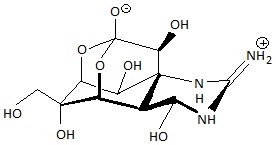About the Toxin
All organisms have grown and changed and adapted over time. Plants gained a waxy cuticle to keep from drying out, flu viruses change from year to year as they become immune to vaccines, and the greater blue-ringed octopus contains a neurotoxin called tetrodotoxin to capture its prey and ward off predators.
 To
the left you will find a picture that I have produced of the tetrodotoxin
chemical. In most organisms, there is a homeostatic balance of sodium
and potassium in the body, especially the nerve cells. Nerve cells
conduct their action potentials by depolarizing and repolarizing at specific
intervals to send an action potential along the axon of the nerve cell.
During this process, there is the opening of sodium ion channels based on
the electric state of the nerve cell. When the cell begins to
depolarize, positive sodium ions are rushed into the cell to maintain that
homeostatic balance. As the cell repolarizes, potassium channels open
to allow the influx of those ions. This neurotoxin, however, is shaped
in a way that imitates the hydrated sodium cation and binds to a structure
within the sodium channel. With the tetrodotoxin molecules blocking
the movement of actual sodium ions, the action potential within the cell
slows to an eventual end. It takes very little, about a single
milligram of this lethal toxin to kill an adult human within hours.
To
the left you will find a picture that I have produced of the tetrodotoxin
chemical. In most organisms, there is a homeostatic balance of sodium
and potassium in the body, especially the nerve cells. Nerve cells
conduct their action potentials by depolarizing and repolarizing at specific
intervals to send an action potential along the axon of the nerve cell.
During this process, there is the opening of sodium ion channels based on
the electric state of the nerve cell. When the cell begins to
depolarize, positive sodium ions are rushed into the cell to maintain that
homeostatic balance. As the cell repolarizes, potassium channels open
to allow the influx of those ions. This neurotoxin, however, is shaped
in a way that imitates the hydrated sodium cation and binds to a structure
within the sodium channel. With the tetrodotoxin molecules blocking
the movement of actual sodium ions, the action potential within the cell
slows to an eventual end. It takes very little, about a single
milligram of this lethal toxin to kill an adult human within hours.
When looking at research done by Becky Williams and Roy Caldwell at the University of California in Berkeley, one can learn that the most concentrated tetrodotoxin is found in the posterior salivary gland of Hapalochlaena lunulata. However, the area with the highest amount of the toxin is the mantle for both the ventral and dorsal sides. More specifically, the skin of the organism holds the most toxin due to the organ's larger mass. One fascinating fact about the tetrodotoxin in the greater blue-ringed octopuses is that it is actually synthesized by a symbiotic bacteria found in the posterior salivary gland. All of the specimens for the experiment were obtained in relatively the same area, yet there was considerable variation in the levels of the toxin within each individual. Because of this, it can be determined that location has little to no effect on the amount of tetrodotoxin found in the greater blue-ringed octopuses.
Continue to Nutrition